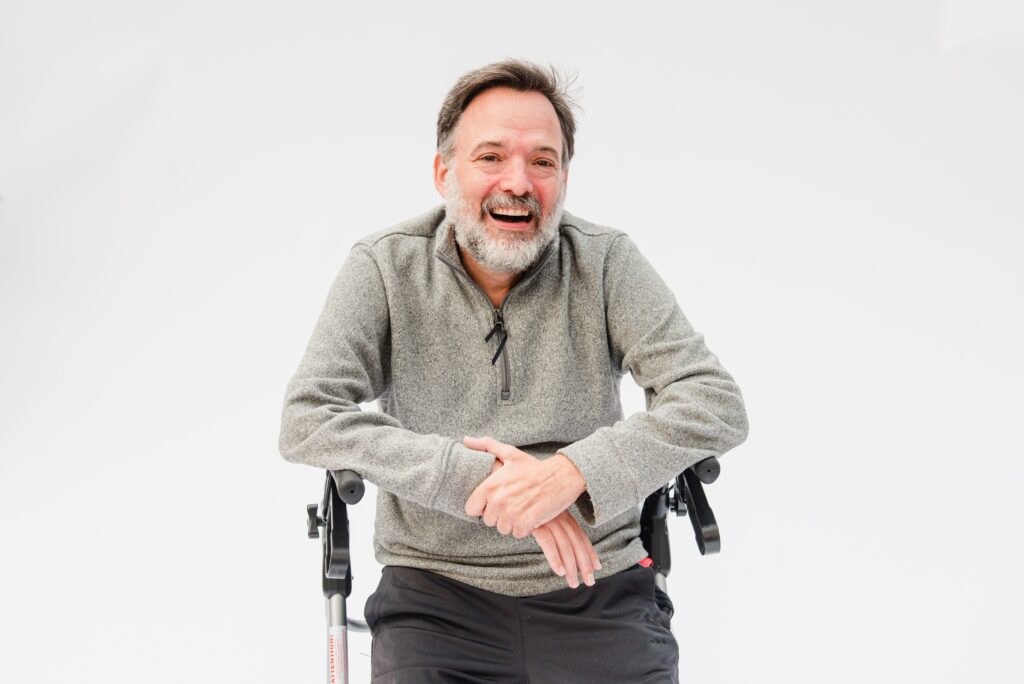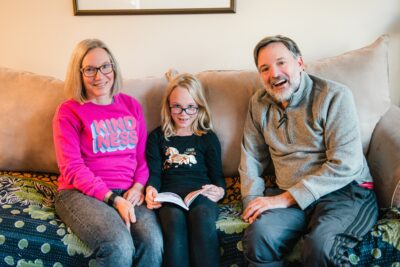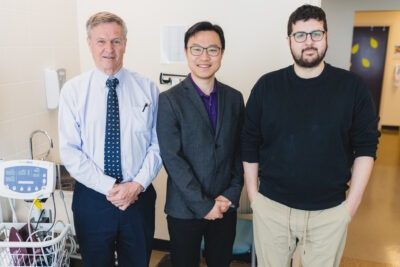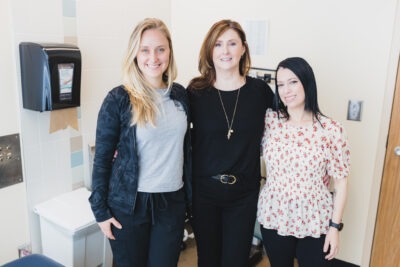
ALS diagnosis transforms storyteller into advocate
“ALS does not define me. My focus is not on dying, but on living every day to the fullest and cherishing moments with my family and friends.” – Steven Gallagher
St. Catharines resident Steven Gallagher spent much of his career as a journalist before switching to public relations with the Niagara Health hospital network.
Then, in 2019, Gallagher found himself on the other side of the health-care system as a patient diagnosed with an incurable illness that has drastically shortened his life expectancy.
“I often say that we all get curveballs thrown our way in life, but being diagnosed with ALS felt like a 100-mile-per-hour fastball to the head,” says Gallagher, 50, who is no longer able to work due to the progressive nature of ALS. Instead, he’s focusing on raising awareness – including sharing his patient experience at Hamilton Health Sciences (HHS) ALS Clinic.
What is ALS?
Amyotrophic lateral sclerosis (ALS) is a disease that affects nerve cells in the brain and spinal cord, causing loss of muscle control. It often starts with muscle twitching and weakness in a limb, or slurred speech. Eventually, it progresses to muscles needed to move, speak, eat and breathe. It gradually paralyzes people because their brain is no longer able to communicate with the muscles in their body. There is no known cure.
Subtle signs
Gallagher started experiencing symptoms in November 2018. “I had been bowling with my then four-year-old daughter Olivia and noticed my hand was stiff and it was harder to move my thumb. A month or so later, I saw my family doctor who sent me for X-rays.”

Steven Gallagher at home with his daughter, Olivia, and her mom, Tiffany, who is also Steven’s caregiver. Photo courtesy of the ALS Society of Canada.
Images showed signs of osteoarthritis, often called overuse arthritis because it’s caused by wear-and-tear. “That seemed logical to me, given my many years typing on a keyboard as a journalist and communications specialist,” says Gallagher.
Over the next few months, his hand stiffness grew worse. “One day, I was having lunch with two orthopedic surgeons at the St. Catharines hospital where I worked. I asked them about my hand, wondering if it was something they could fix. They took the time to look at my hand and forearm and noticed slight muscle atrophy. They encouraged me to see a neurologist as soon as possible. I’m very grateful to them both for pointing me in the right direction.”
The Niagara Health neurologist referred Gallagher to the HHS ALS Clinic where the diagnosis was confirmed in August 2019.
“The diagnosis devastated me and my family at the beginning, but that darkness eventually turned to light because of many factors including the care provided by the ALS Clinic team at Hamilton Health Sciences.”
A leading Canadian clinic

ALS Clinic neurologists Dr. John Turnbull, Dr. Marvin Chum and Dr. Matthew Gladman.
The HHS ALS Clinic is among the largest in Canada, and one of only five in the province. It was founded by neurologist Dr. John Turnbull in the early 1990s. Today, Turnbull is one of three clinic neurologists along with Dr. Marvin Chum and Dr. Matthew Gladman. The core team also includes nurse coordinator Barb Miller, social worker Suzanne Zietsma and respiratory therapist Jenneca Herceg. They also connect patients to hospital and community support needed to live safely and independently at home. Gastroenterologist Dr. Siwar Albashir, physical medicine and rehabilitation specialist Dr. Adrian Opala and respirologist Dr. Andreas Freitag also play key roles in supporting patients.
The clinic follows 250 to 300 patients at any one time from as far away as Kenora, Dryden, Sioux Lookout and Thunder Bay, with three to four new patients a week. It’s also one of the largest clinics in the country for research trials through a partnership with McMaster University.

Core team members include respiratory therapist Jenneca Herceg, nurse coordinator Barb Miller and social worker Suzanne Zietsma.
Patients typically have clinic appointments every three months and can contact the team at any time as needed. The pandemic introduced secure telephone and video conferencing instead of in-person appointments, which is much easier for patients and their families.
“The team does an excellent job of keeping our patients out of hospital emergency departments and intensive care units by thinking ahead to their future needs, to help avoid a crisis,” says Turnbull. “This benefits the health-care system, the hospital and our patients who would much rather be at home than in a hospital bed.”
Team members form close relationships with patients and their families,” adds Miller. “ALS is a family disease because families provide so much support.”
Gallagher meets with the team every three months through video conferencing. “They guide me on my journey, always thinking a few steps ahead so my family and I are prepared for each stage of the disease,” he says. “They also make sure I’m receiving the latest medication to slow the progression.”
Improved quality of life through early intervention
Early diagnosis is key to helping ALS patients enjoy the best quality of life for as long as possible, says Dr. Marvin Chum, Gallagher’s neurologist at the ALS Clinic.
Yet it’s common for people experiencing symptoms to circulate through the health-care system, undergoing numerous tests and specialist referrals before finally arriving at an ALS Clinic. Currently, in Canada, it can take two years or more for someone to be diagnosed with ALS, according to the ALS Society of Canada.
These patients don’t have the luxury of time, says Chum. “Half will pass away in three to four years from the time of symptom onset so it’s critically important that they’re diagnosed as early as possible and start taking medication to slow the disease’s progression.”
Chum encourages community physicians and specialists to immediately refer patients to the clinic if they suspect ALS. “There’s no need to order tests or wait for results before referring to us. We can do all that here, very quickly.”
Advocating for awareness
After being diagnosed at the clinic, Gallagher immediately started taking medication to slow the disease. For the first year-and-a-half, his ALS progressed slowly. “It was really only my right hand that was impacted. I was still quite active — running, cycling and playing golf and tennis.” In the spring of 2021, he started to experience breathing issues and by summer he used a cane to walk.
“Today, my overall mobility is very weak,” says Gallagher, adding that breathing has also become much more challenging and his speech is now impacted.
Even so, he remains a champion for the ALS Society of Canada, helping to raise awareness. “It’s an honour to lend my voice to the chorus of people fighting for change,” says Gallagher.
“Even as this disease slowly robs me of my speech, it will never silence me when it comes to advocating for advances in care.”
